“USAC (University Studies Abroad Consortium) is currently responsible for 63 American students who are studying abroad in Chiang Mai for the semester at Chiang Mai University.
In addition to the multiple field trips that USAC organises for its students, certain courses require students to attend these trips, all of which are followed up by assignments reflecting on our experience.
Amongst the culture shock, food poisoning and weird dreams that students on my trip were experiencing in the midst of being immersed into a completely unfamiliar culture, students were thrilled to further push their boundaries by paying an overnight visit to the Mae Sa Mai Hmong village in the Mae Rim district.”
When we first arrived at the village, located in the highlands of Northern Thailand, we immediately dropped our bags and set forth on a five-hour hike.

Photograph by Sumya Paung
“Four jaguars live out there. They are our friends,” said Win, our tour guide.

Tourguide Salmee overlooks his village, photograph by Sumya Paung
Many students on my American foreign exchange group were taken aback by this. What about the children of the village? Aren’t the Hmong people afraid that the jaguars will attack?
Upon returning to the office, I realised that I had been slightly misdirected through lost translation and that by ‘Jaguars,’ Win meant wild cats, which can also be dangerous to small children, but was not quite as chilling of a threat as it initially sounded. The idea of roaming jaguars in the night did add to our experience at the time though!
In spite of this, the fact of the matter is that the people of the Mae Sa Mai Hmong Village have, for centuries, have lived completely in sync with nature. Their fearless demeanor comes from their experiences and belief in animism, which infuses all entities, human or not, with a soul.
Deep into our trek through rough mountainous terrain on that first day, led by our cheerful guide Win, we were told that each and every plant we passed had a different story and the Hmong people seemed to have known them all. Plant uses range from being the main ingredient for homemade toothpaste to soothing wounds to helping with childbirth.
Four hours, several leg cramps and multiple mudslide slips from where we began, we found ourselves surrounded by mountainous jungle in every direction. Along with the mass of dirt and dust we were inhaling were wisps of different sweet, bitter and tangy scents – jungle scents. These smells were new to us, and we breathed them in with relish. The vast mountain range has traditionally contained a plethora of resources for the Hmong people and their farmlands are covered with seems like every crop under the sun; strawberries, potatoes, rice, tomatoes…you name it. We walked and learned, asked questions and walked some more. It was an exhausting but illuminating day, and I had enough information to fill my entire university newspaper, let alone the one column I was tasked with writing.
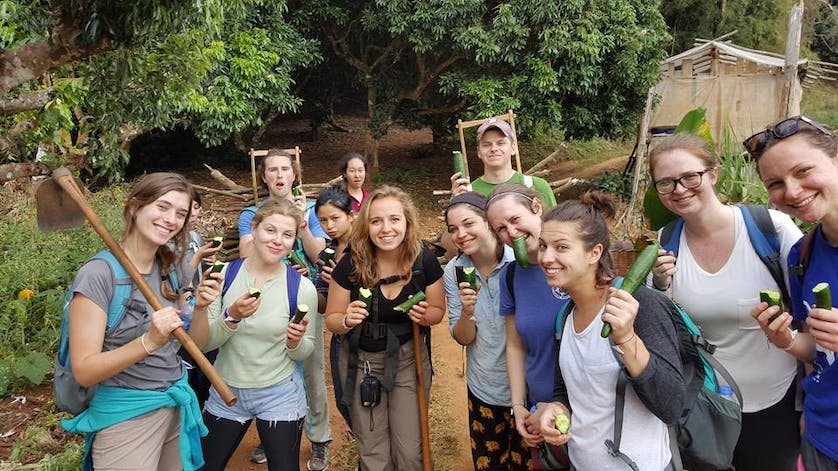
Students eat cucumbers grown at the village. Photograph by Joon Pongsak Rattanawong
At one point, Win encouraged us to experience the long tradition of ‘Slash and Burn’, something that is still common practice, but again, upon return to the office, I realised was now not only frowned upon, but illegal. Win explained that once the crop was cut, the Hmong people carry their crops down to the main village before returning to the fields to burn them. “The reason Hmong people are so short is from carrying baskets all the time,” he laughed. I laughed too because I thought he was joking, but as it turns out, he was serious. There were a few things said by Win that my fellow students and I are still today unsure whether he was teasing us or being serious. The culture was so different from our own that it was hard for us to gauge.

Tourguide Salmee teaches students how to ‘Slash,’ photograph by Sumya Paung
A lot of the information we learned on that hike baffled us. We learned that if you throw something at a snake from afar, it can reach and kill you within seconds. “When you try to kill a poisonous snake, you hit it in the head with bamboo. If you try to cut its head off, it will fly toward you and bite you,” our other tour guide, Salmee, said. Our eyes widened like saucers at the image, even though our minds held us back through cynicism.

Salmee explains some uses of bamboo. Photograph by Sumya Paung
Upon returning to the main village, we set down the back-wrenching firewood that we had gathered and finally took a rest. Waiting for us, was a woman in traditional Hmong attire, designing the beginnings of a tapestry. Each of us was able to use her ink tool and sign his or her name. It had been a long day and we were exhausted and covered in mounds of sweat and dirt. But we soldiered, on, fascinated with our adventure.
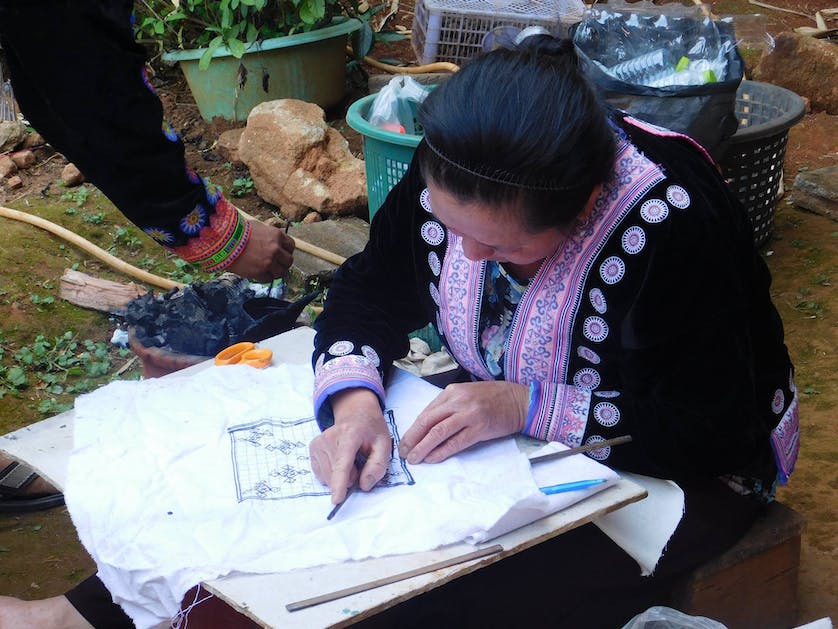
Photograph by Sumya Paung
We were then split up into groups of eight to ten and dispersed to go to our homestay families. The intense language barrier was frustrating and in spite of our best intentions, and theirs, our interactions with our host family were awkward, to say the least. It was slightly disappointing that we were unable to get to know any of our host family’s personalities or engage in any meaningful conversation with them – there was plenty of smiling, waiing, and pointing. Many students managed to help prepare dinner despite this difficulty, “food is something that can bridge communication. My host mother demonstrated how I should chop the tomatoes and mix together ingredients, a pretty easy task that felt significant because we were able to understand each other without a single spoken word,” Teisha Adlish, one of my fellow students, said.
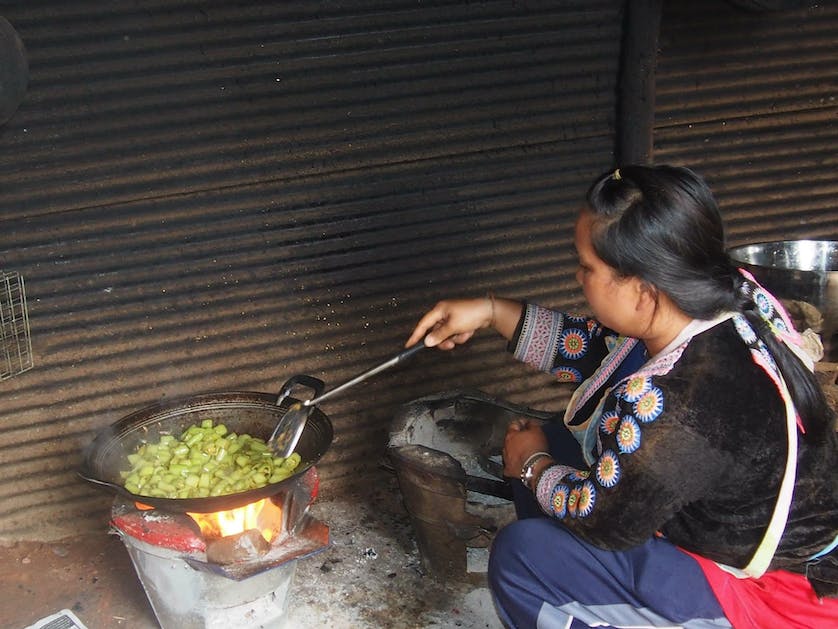
A host-mother cooks dinner. Photograph by Nun Gooner
Dinner consisted of a brothy soup, rice, chicken and a salsa-like dish, which our host-mother specially made for us.
After our dinner, we all returned to the communal area, started a camp fire and even without the luxury of a shower, listened in fascination as Win continued to talk about the Hmong way of life. “I believe that every person has a different image of god but my real belief is in the human body. We can all feel pain and there should never be a war over god,” Win said. “The main religion here is our ancestors and the circle of life.”
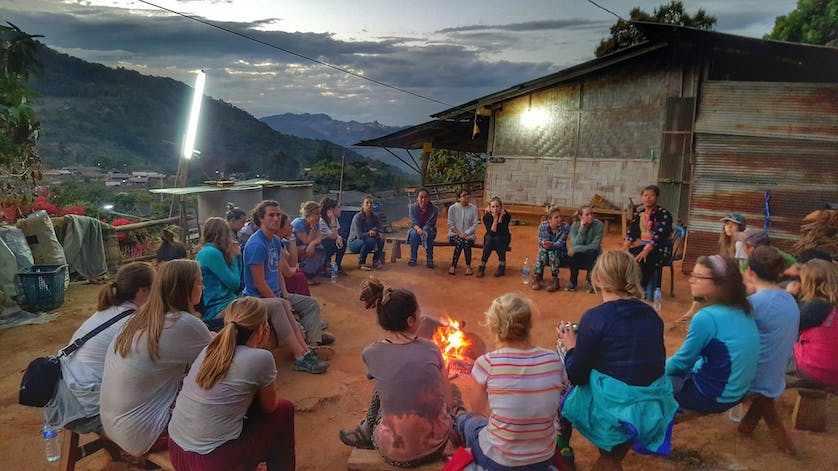
Photograph by Joon Pongsak Rattanawong
Without any prior warning, we were suddenly told that we were to participate in a cultural talent show. The goal was that both the Hmong people and American students would have the chance to share traditions of their culture. Smelly, tired and completely unprepared, we were given a few moments to awkwardly huddle and come up with a plan. As our show continued to percolate in our heads we watched our hosts perform an array of different traditional dances, instruments, tools and martial art techniques with us. Then it was our turn. Unfortunately all our collective creativity could come up with was country music. Although I didn’t feel that this was the best representation of American culture, whatever that even is, and I can’t stand country music, the singing was in beautiful harmony and the village people seemed loved it.
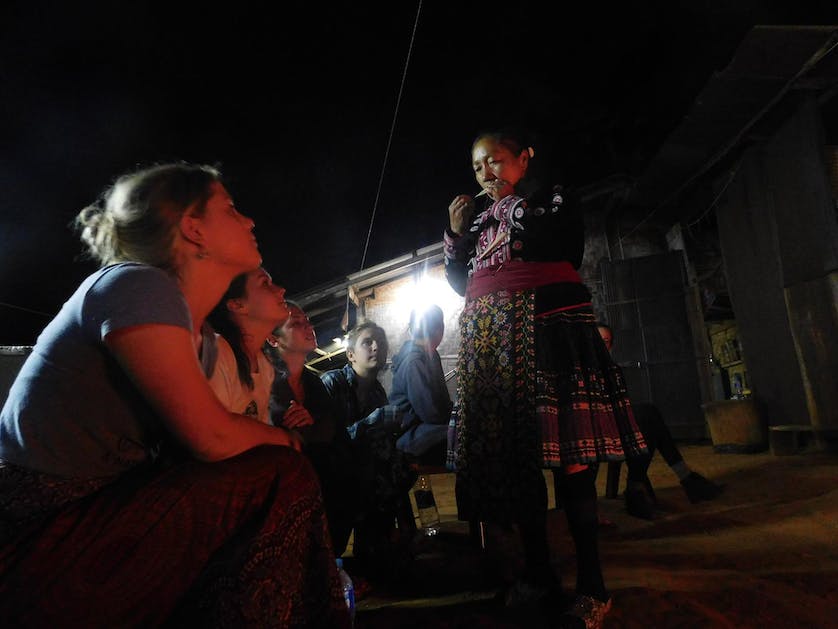
Photograph by Sumya Paung
Exhausted from the day, and relieved that we hadn’t completely humiliated ourselves, we were ready for slumber and we returned to collapse on mattresses and pillows our host family had graciously set up for us on the floor.
Unfortunately, as a result of my unfamiliar surroundings and rooster’s ‘Cocka-doodle-doo-ing’ all night long, I couldn’t sleep a wink. Instead, I spent the night obsessing over rooster calls. Where I come from its cocka-doodle-doo, but for some bazaar reason, the last doo was mainly missing, as though they were strangled mid call. I also noticed that there seemed to be a leading rooster, which coincidentally was located directly outside my window. He led the chant for the entire rooster village, all night long.
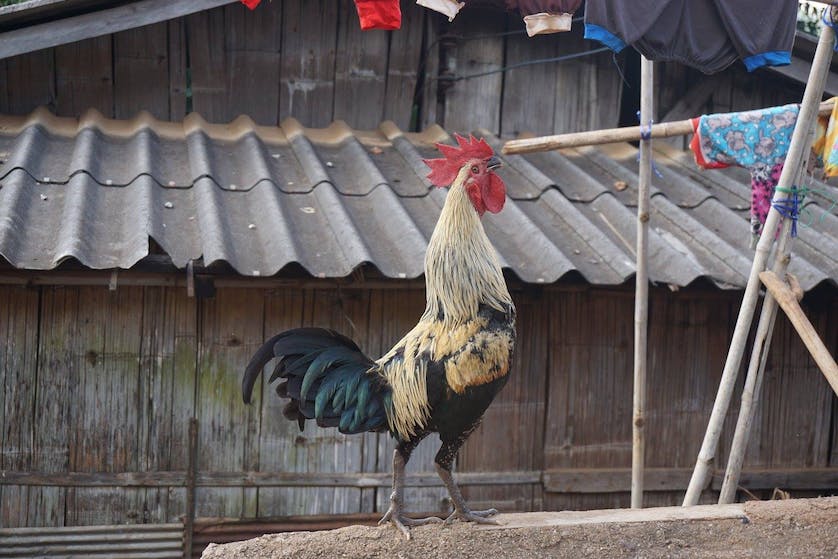
Photograph by Lauren Hamilton

Sunrise rolls over the Hmong Village. Photograph by Joon Pongsak Rattanawong
Before leaving the next day, we were given the opportunity to visit in with the Shaman who grants spiritual protection to the Hmong people. After a prayer was done directed toward each of us, we were provided bracelets as a means of our spiritual protection. The bracelet must come off by natural causes. If not, this could result in the loss of ones soul, at least, according to some online research I did.

Students visit in with the Shaman. Photograph by Sumya Paung
“You are not tourists anymore, you are family,” Win said as we prepared to set our different ways. “We are proud that we could exchange ideas and experiences so we can better see the world. We have only one word for you, ‘Ua tsaug wa chow’, thank you.”
I came out of this short trip filled with wonder at how, with so little, lives can be so enriched and so much knowledge can be amassed. The knowledge infused into daily life of their surroundings, environments and its usage and influences was humbling and it shows that so much can be learned even when you have so little.
